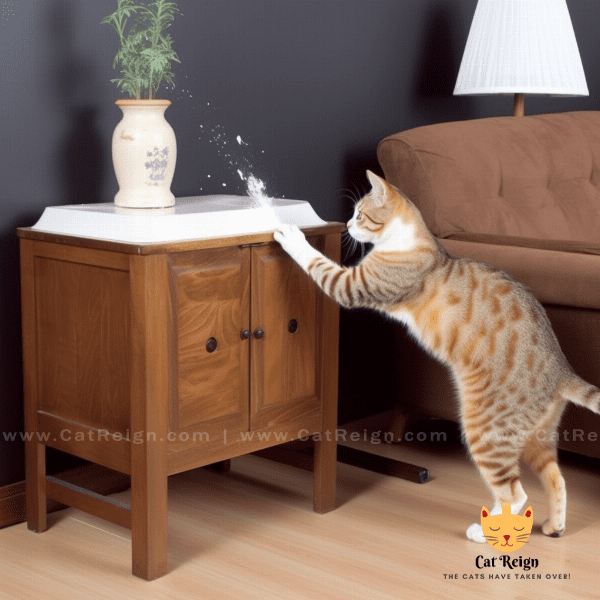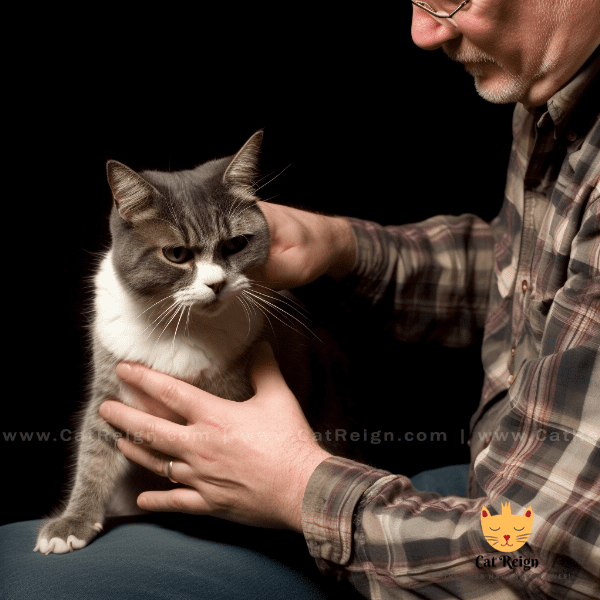Table of Contents
- Understanding Why Cats Scratch Carpet
- Redirecting Your Cat’s Scratching Behavior
- Providing Appropriate Scratching Surfaces
- Training Your Cat to Use Scratching Posts
- Deterrents and Repellents for Carpet Scratching
- Repairing and Preventing Carpet Damage
- Consistency and Patience in Correcting Cat Scratching
- Alternative Options for Cats Who Persist in Scratching Carpet
- Seeking Professional Help for Severe Cases
- Conclusion: Enjoying a Carpet-Scratch-Free Home with Your Feline Friend
Understanding Why Cats Scratch Carpet
Scratching is a natural and instinctive behavior for cats. It serves multiple purposes, including stretching and strengthening muscles, marking territory, and maintaining claw health. While scratching may be an essential activity for your cat’s wellbeing, it can cause damage to your home, particularly your carpets.
Carpet Texture
One of the main reasons cats scratch carpet is due to its texture. Carpet provides a satisfying texture for scratching and allows cats to dig in their claws, which helps them release energy and maintain healthy claws. If your cat does not have access to appropriate scratching surfaces, they may resort to scratching your carpets instead.
Boredom and Stress
Cats may also scratch carpets out of boredom or stress. Indoor cats, in particular, may become bored if they do not have enough mental and physical stimulation, leading to destructive behaviors such as scratching. Additionally, stress, anxiety, or changes in their environment can cause cats to resort to carpet scratching as a coping mechanism.
Territorial Marking
Cats are territorial animals, and they use scent and scratch marks to communicate their presence and establish their territory. By scratching carpets, cats leave visual and olfactory cues that signal to other animals that the area is theirs. If you have multiple cats or other pets in your home, they may feel the need to scratch carpets to assert their dominance.
Age and Health
Finally, it is essential to consider your cat’s age and health when addressing carpet scratching behavior. Older cats or those with mobility issues may have difficulty reaching appropriate scratching surfaces, leading them to scratch carpets instead. Additionally, cats with health problems, such as arthritis, may use carpet scratching as a way to alleviate discomfort or pain.
Understanding why your cat scratches carpets is crucial to finding appropriate solutions to redirect their behavior. By identifying the underlying causes, you can provide your feline friend with the support they need to maintain their wellbeing while also protecting your carpets.

Redirecting Your Cat’s Scratching Behavior
Redirecting your cat’s scratching behavior is essential to protect your carpets while also providing your feline friend with appropriate outlets for their scratching needs.
Temporary Deterrents
If your cat continues to scratch your carpets despite the presence of appropriate scratching surfaces, you may need to use temporary deterrents. These can include covering the carpet with a plastic carpet runner or aluminum foil, which can be unappealing to your cat’s paws. Alternatively, you can use double-sided tape or a citrus-scented spray to discourage your cat from scratching in that area.
Avoid Punishment
It’s essential to avoid punishing your cat for carpet scratching. Punishment can lead to anxiety, stress, and even worsen their scratching behavior. Instead, focus on positive reinforcement and redirecting their behavior to appropriate scratching surfaces.
Redirecting your cat’s scratching behavior may take time and patience, but with consistency and positive reinforcement, you can protect your carpets and provide your feline friend with the outlets they need to maintain their wellbeing.
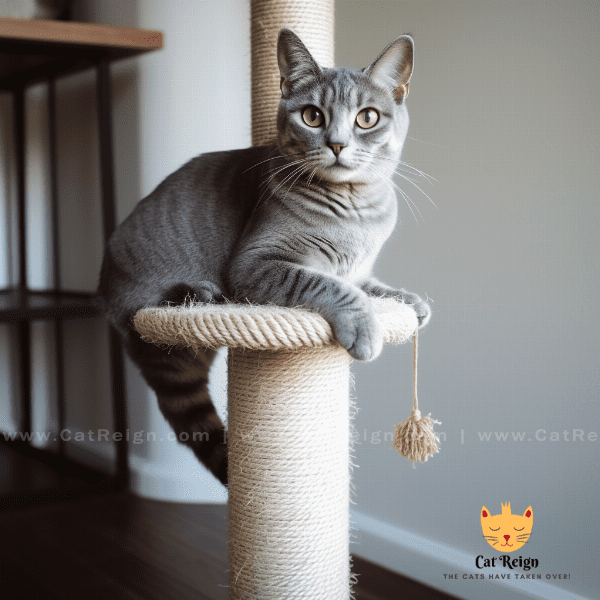
Providing Appropriate Scratching Surfaces
Scratching Posts
Scratching posts are the most popular and effective way to provide your cat with appropriate scratching surfaces. They come in various shapes, sizes, and textures, such as sisal, carpet, or cardboard. Place them in areas where your cat spends most of their time, such as near their sleeping spot, to encourage them to use the post instead of your carpets.
Scratching Pads
Scratching pads are another popular option and are typically made of cardboard or sisal. They are smaller and more portable than scratching posts, making them ideal for households with limited space. You can place them on the floor, furniture, or walls to provide your cat with a variety of scratching options.
Horizontal Surfaces
Some cats prefer to scratch horizontal surfaces rather than vertical ones. Providing them with appropriate horizontal surfaces, such as flat scratching pads or corrugated cardboard, can redirect their behavior from your carpets.
Cat Trees and Condos
Cat trees and condos provide multiple levels and surfaces for your cat to scratch, climb, and play. They often include scratching posts, pads, and surfaces, making them an excellent option for cats who enjoy climbing and scratching.
Providing your cat with appropriate scratching surfaces is essential to redirect their behavior from your carpets. By offering a variety of options, you can find the surfaces that best meet your cat’s preferences and needs while also protecting your home.

Training Your Cat to Use Scratching Posts
Training your cat to use scratching posts is crucial to redirect their behavior from your carpets. With patience and consistency, you can encourage your cat to use appropriate scratching surfaces.
Placement
Proper placement of scratching posts is crucial to encourage your cat to use them. Place them in areas where your cat spends most of their time, such as near their sleeping spot, to make them more appealing. You can also try placing them in areas where your cat has already been scratching, such as near damaged carpets, to redirect their behavior.
Positive Reinforcement
Positive reinforcement is a powerful tool for training your cat to use scratching posts. When your cat uses the scratching post, provide them with treats, praise, and attention. This positive reinforcement will encourage them to continue using the post. You can also try playing with your cat near the scratching post to make it a more appealing and enjoyable area.
Scent and Attractants
Applying catnip or other attractants to scratching posts can make them more appealing to your cat. Additionally, placing toys or treats near the post can encourage your cat to use it.
Training Tools
There are several training tools available to encourage your cat to use scratching posts. Double-sided tape or a citrus-scented spray can be applied to carpets to deter your cat from scratching them. Alternatively, you can use a clicker to train your cat to use the scratching post.
Patience and Consistency
Training your cat to use scratching posts may take time and patience, but with consistency and positive reinforcement, you can redirect their behavior. It’s essential to avoid punishment and be patient with your cat as they learn to use the scratching post.
Training your cat to use scratching posts is a crucial step in protecting your carpets and providing your feline friend with appropriate scratching surfaces. With patience, consistency, and positive reinforcement, you can train your cat to use the scratching post and enjoy a carpet-scratch-free home.
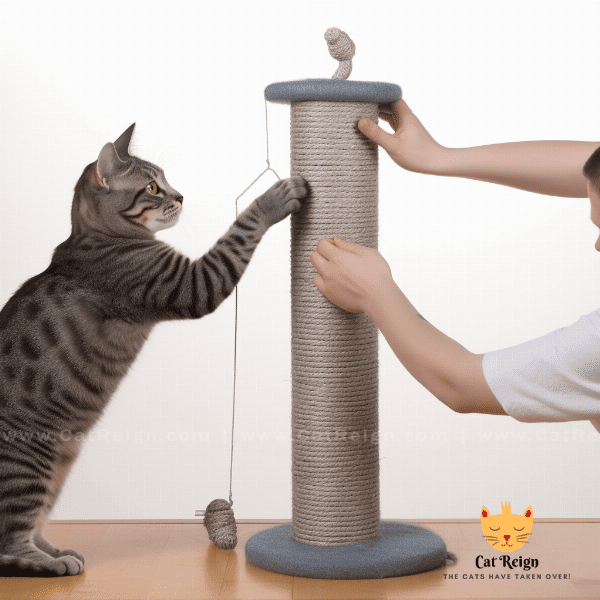
Deterrents and Repellents for Carpet Scratching
If your cat continues to scratch your carpets despite your efforts to redirect their behavior, you may need to use deterrents and repellents to discourage them from scratching in that area.
Double-Sided Tape
Double-sided tape is an effective way to deter your cat from scratching carpets. Cats do not like the sticky feeling of the tape on their paws and will avoid scratching in that area. Place the tape on the carpet in the areas where your cat has been scratching.
Aluminum Foil
Aluminum foil can also be used to deter your cat from scratching carpets. The sound and texture of the foil are unappealing to cats and can discourage them from scratching in that area.
Citrus-Scented Spray
Cats do not like the scent of citrus, and a citrus-scented spray can be used to deter them from scratching carpets. Spray the area where your cat has been scratching with the citrus-scented spray to discourage them from scratching in that area.
Deterrent Mats
Deterrent mats are designed to discourage cats from scratching in specific areas. They emit a static shock or noise when the cat steps on them, which can deter them from scratching in that area.
Furniture Covers
If your cat has been scratching a specific piece of furniture, you can use a furniture cover to protect it. Furniture covers are made of materials that are unappealing to cats, such as plastic or vinyl, and can deter them from scratching.
It’s essential to use deterrents and repellents in conjunction with positive reinforcement and appropriate scratching surfaces. Deterrents should be used as a temporary measure while you redirect your cat’s scratching behavior. With consistency and patience, you can train your cat to use appropriate scratching surfaces and enjoy a carpet-scratch-free home.

Repairing and Preventing Carpet Damage
Even with appropriate scratching surfaces and training, your cat may still cause damage to your carpets. It’s essential to address any damage as soon as possible to prevent further destruction.
Repairing Carpet Damage
If your cat has already caused damage to your carpets, it’s essential to repair it as soon as possible. Depending on the extent of the damage, you may be able to repair it yourself or hire a professional. Small scratches or snags can be repaired using a carpet repair kit, while more extensive damage may require the help of a professional carpet cleaner.
Preventing Carpet Damage
Preventing further damage to your carpets requires a combination of deterrents, positive reinforcement, and appropriate scratching surfaces. Deterrents, such as double-sided tape or aluminum foil, can be used to discourage your cat from scratching in specific areas. Positive reinforcement and training can redirect your cat’s scratching behavior to appropriate surfaces, such as scratching posts and pads. Providing a variety of scratching surfaces can also prevent your cat from becoming bored or frustrated and resorting to carpet scratching.
Carpet Protection
You can also protect your carpets by using products designed to prevent damage from Cat scratching. Carpet protectors or covers can be placed over high-traffic areas or areas where your cat has been scratching to prevent further damage.
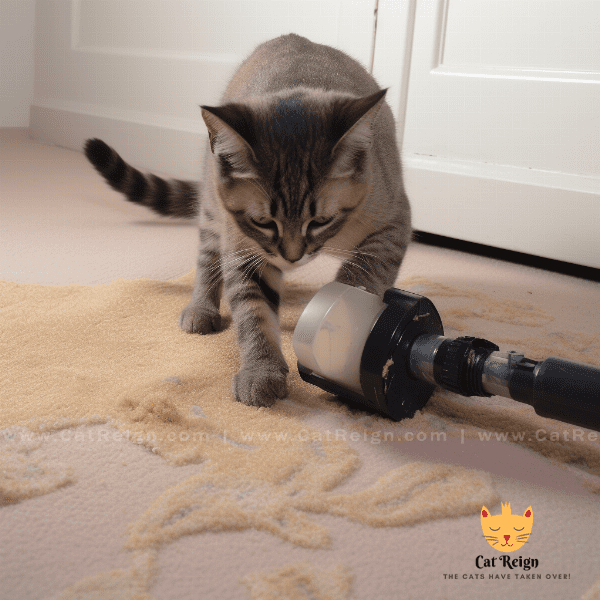
Consistency and Patience in Correcting Cat Scratching
Be Consistent
Consistency is key when correcting your cat’s scratching behavior. Make sure your cat has access to appropriate scratching surfaces in all areas of your home, and place them in areas where your cat spends most of their time. Use positive reinforcement, such as treats and attention, when your cat uses appropriate scratching surfaces. Deterrents, such as double-sided tape or citrus-scented spray, should also be applied consistently in areas where your cat has been scratching.
Be Patient
Correcting your cat’s scratching behavior may take time, and it’s essential to be patient. Avoid punishing your cat for carpet scratching, as this can worsen their behavior and cause stress and anxiety. Instead, focus on positive reinforcement and redirecting their behavior to appropriate scratching surfaces. With patience and consistency, your cat will learn to use the scratching post and other appropriate surfaces.
Seek Professional Help
If your cat’s scratching behavior persists despite your efforts, it may be time to seek professional help. A veterinarian or animal behaviorist can provide guidance and support in redirecting your cat’s behavior. They may also be able to identify any underlying medical or behavioral issues that may be contributing to the behavior.
Correcting your cat’s scratching behavior requires consistency and patience. With appropriate training, positive reinforcement, and patience, you can redirect your cat’s behavior and enjoy a carpet-scratch-free home.
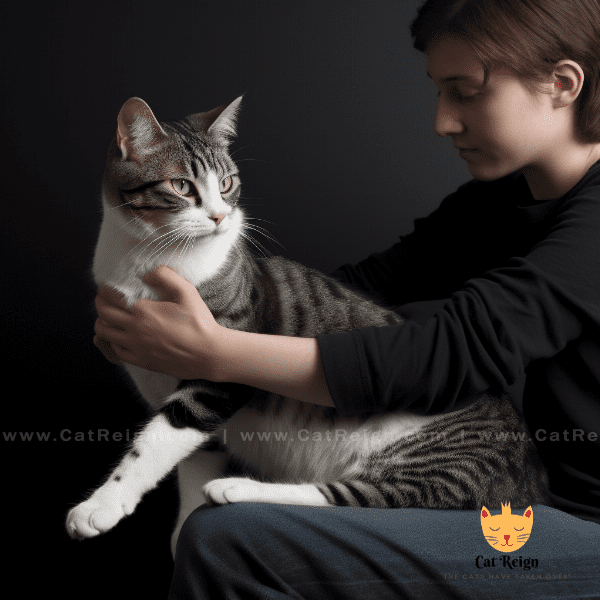
Alternative Options for Cats Who Persist in Scratching Carpet
If your cat persists in scratching your carpets despite your efforts to redirect their behavior, there are alternative options to consider.
Soft Paws
Soft paws are plastic nail caps that can be applied to your cat’s claws to prevent them from causing damage when scratching. Soft paws are a safe and humane option, and they do not interfere with your cat’s natural scratching behavior.
Claw Clipping
Claw clipping is another option for cats who persist in scratching carpets. Regular claw clipping can prevent damage to your carpets and furniture. It’s essential to use proper techniques and tools when clipping your cat’s claws to avoid injury.
Outdoor Access
If your cat continues to scratch your carpets despite your efforts to redirect their behavior, providing outdoor access may be an option. Outdoor access can provide your cat with a variety of scratching surfaces and may reduce their desire to scratch indoors.
Cat Enclosures
Cat enclosures are an alternative to outdoor access and can provide your cat with a safe and secure outdoor space to play and scratch. Enclosures come in various sizes and can be customized to meet your cat’s needs.
Alternative options for cats who persist in scratching your carpets should be considered as a last resort. It’s essential to try all other options, such as training and appropriate scratching surfaces, before resorting to alternative options. With patience, consistency, and appropriate training, most cats can be redirected from carpet scratching and provided with appropriate outlets for their scratching needs.
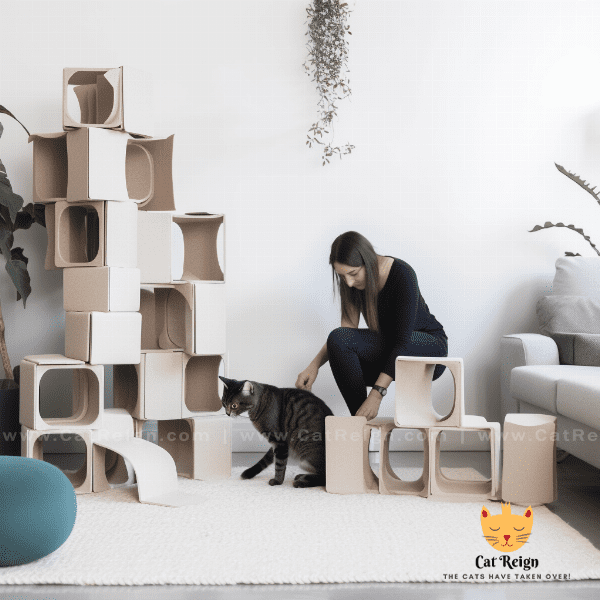
Seeking Professional Help for Severe Cases
Medical Issues
Medical issues, such as allergies or skin conditions, can cause your cat to scratch excessively. A veterinarian can identify and treat any underlying medical issues that may be contributing to your cat’s scratching behavior.
Behavioral Issues
Behavioral issues, such as anxiety or stress, can also contribute to your cat’s scratching behavior. An animal behaviorist can identify any underlying behavioral issues and provide guidance and support in redirecting your cat’s behavior.
Medications
In some cases, medications may be necessary to treat underlying medical or behavioral issues. Your veterinarian or animal behaviorist can prescribe medications to help manage your cat’s scratching behavior.
Last Resort Options
In severe cases, last resort options such as declawing or rehoming may be considered. It’s essential to explore all other options before considering these alternatives. Declawing is a controversial and painful procedure that should only be considered as a last resort. Rehoming your cat should also be a last resort and should only be considered if all other options have been exhausted.
Seeking professional help for severe cases of carpet scratching can provide you with the guidance and support you need to redirect your cat’s behavior. With proper treatment and management, your cat can live a happy and healthy life while also protecting your carpets.

Conclusion: Enjoying a Carpet-Scratch-Free Home with Your Feline Friend
Living with a cat doesn’t mean sacrificing your carpets to their scratching needs. With the right approach, you can redirect your cat’s behavior and enjoy a carpet-scratch-free home.
Understanding Why Cats Scratch
Understanding why cats scratch is the first step in redirecting their behavior. Scratching is a natural behavior for cats, and they do it for several reasons, including to stretch, mark their territory, and maintain their claws.
Redirecting Your Cat’s Scratching Behavior
Redirecting your cat’s scratching behavior requires a combination of strategies, including appropriate scratching surfaces, positive reinforcement, and deterrents. Providing your cat with appropriate scratching surfaces, such as scratching posts and pads, can redirect their behavior from your carpets. Positive reinforcement and training can encourage your cat to use appropriate scratching surfaces, while deterrents can discourage them from scratching carpets.
Repairing and Preventing Carpet Damage
Preventing and repairing carpet damage requires a combination of strategies, including appropriate training, positive reinforcement, and the use of carpet protectors and covers. With patience and consistency, you can prevent further damage to your carpets and protect your home.
Seeking Professional Help
In severe cases of carpet scratching, seeking professional help may be necessary. A veterinarian or animal behaviorist can provide guidance and support in redirecting your cat’s behavior and managing any underlying medical or behavioral issues.
Living with a cat doesn’t mean sacrificing your carpets. With patience, consistency, and the right approach, you can enjoy a carpet-scratch-free home with your feline friend.


